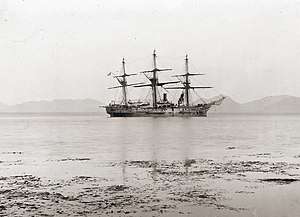Zilveren Kruis-class corvette
The Zilveren Kruis class was a class of two steam corvettes of the Royal Netherlands Navy. The class comprised the Zilveren Kruis and the Van Galen.
 The Zilveren Kruis | |
| Class overview | |
|---|---|
| Name: | Zilveren Kruis class |
| Builders: | Rijkswerf Amsterdam |
| Operators: |
|
| Preceded by: | Djambi class |
| In commission: | 1870-1920 |
| Planned: | 2 |
| Completed: | 2 |
| Scrapped: | 2 |
| General characteristics | |
| Type: | Steam Corvette |
| Displacement: | 2,160 tons |
| Length: | 59.00 m (193 ft 7 in) |
| Beam: | 12.75 m (41 ft 10 in) |
| Draught: | 5.50 m (18 ft 1 in) |
| Installed power: |
|
| Speed: | 10.5 knots (19.4 km/h)[1] |
| Complement: | 225 |
| Armament: | 4 × 18 cm RML and 8 x 16 m RML |
| Armour: | ship made of wood |
A false believe that no armored ships would appear in the colonies
The career officer Willem Huyssen van Kattendijke became Secretary for the navy on 14 March 1861. He wanted to have a fleet centered on screw frigates. The March 1862 Battle of Hampton Roads then showed that these were defenseless against armored ships. It put a temporary an end to plans to build new wooden steam frigates. In the 1864 Shimonoseki Campaign unarmored Dutch ships then performed quite well. It led some to believe that armored ships might not be that important in the colonies.
The secretary for the navy therefore started the first ship of the 'Anna Paulowna' class in 1864. It was supposed to be a class of 'Kuilkorvetten', a corvette that had its main battery below the upper deck. Later on these would be dubbed as 'steam frigates'. Considering that their size of 3.398 t made them bigger than most frigates in the Dutch navy, this was a better designation. On 1 June 1866 G.C.C. Pels Rijcken became the new secretary for the navy. He made a radical choice to build an armored fleet.
A lack of ships in the Dutch East Indies
As a consequence of the choice for an armored fleet the new Secretary for the navy canceled the Anna Paulowna class and the Watergeus class. This meant that of the former only one ship would be finished, and that the third ship of the Watergeus class would be canceled. In the meantime, many ships of the previous classes that were stationed in the East Indies would become unfit for service. Therefore, the Secretary had to order some new ships. For this he fell back on the design of the Djambi's. He ordered some ships of the type: 'improved Djambi'
Characteristics
The Zilveren Kruis class were a class of steam corvettes. The official Dutch classification was 'Schroefstoomschip 1e klas'. It translates as Screw Steam Ship 1st class, and was an administrative designation that could be changed as other types of screw steamships (dis)appeared. The Zilveren Kruis was the last class of wooden corvettes that the Dutch navy would build.
An improved Djambi
The Zilveren Kruis class was based on the design of the Djambi class. It was even called 'type Djambi', or more often 'type improved Djambi'. There were some very solid reasons to do this. Naval Secretary Lotsy had ordered the construction of the Djambi's. His successor Huyssen van Kattendijke had stopped the Djambi program and started the Anna Paulowna class and the Watergeus class. When Pels Rijcken succeeded to the office it was obvious that he would not make himself popular if the started yet another type of ships.
The discontinuation of the Djambi class by Huyssen van Kattendijke alone is enough to classify the Zilveren Kruis as a separate (sub)class of ships. A closer look at the Zilveren Kruis' armament and propulsion shows a clear difference between the classes. While the Djambi was outrun and outgunned by English steam corvettes, the same could not be said about the Zilveren Kruis. Her propulsion and armament were almost in line with the ships of the Great Powers.
Dimensions
The Zilveren Kruis class was 59.00 meters long, one meter longer than the Djambi class. The draft of 5.5 meters was the same, but had more to do with being able to enter the Surabaya harbor with all tides. The width was 0.5 m wider, probably to prevent the problems the Djambi had with having enough space to use her guns. With 2,160 t vs 2,030 t the Zilver Kruis class was nog that much larger than the Djambi's.
Propulsion
The first real improvement that the Zilveren Kruis brought was in its machinery. With 280 nominal horsepower the Zilveren Kruis had only 30 nominal horsepower more than the Djambi or the Vice-Admiral Koopman class. In indicated horsepower however, the difference was dramatic: 1480 ihp vs 700 ihp.[2] The effect was that the Zilveren Kruis had a maximum speed of 10.5 kn, two knots more than the Djambi.[3]
This success came at a price for the factory Van Vlissingen en Dudok van Heel, later Koninklijke Fabriek van Stoom- en andere Werktuigen. While testing the machine, the screw did not achieve the projected number of turns per minute. The Zilveren Kruis did attain the designed speed, but the factory was nevertheless forced to pay a fine of 22,000 guilders[4] When a machine for the Van Galen had to be bought, the navy decided to transplant the machines of the Zoutman. This brought the speed of the Van Galen down to the 8.5 knots of the Djambi's.
Armament

The Zilveren Kruis class was armed with 4 18 cm Armstrong RML, and 8 rifled muzzle loaders of 16 cm. The 18 cm guns were positioned aft on pivots. The 16 cm guns more forward.[5] The 18 cm Armstrong guns were able to penetrate armored ships. For the 16 cm guns this was rather doubtful.
The arms of the Zilveren Kruis were later replaced. When she was retired in October 1888 she had 10 12 cm breech loaders[6]
Construction
Both ships were built at the Rijkswerf in Amsterdam.
Zilveren Kruis
The Zilveren Kruis was laid down on 18 June 1865 as the Anna Paulowna, the second ship of the Anna Paulowna class.[7] In July 1865, the Anna Paulowna was mentioned as being 80 meters long.[8] In the first half of 1866, the construction of the Anna Paulowna was stopped.[9] In February 1867 the secretary for the navy mentioned that the Anna Paulowna could perhaps be made into a somewhat altered Djambi, especially because the wood that had been used would otherwise go to waste.[10]
On 20 March 1867, the name of the first ship of the Anna Paulowna class, that is the 'Van Galen', was changed to 'Anna Paulowna', before the ship was launched in Amsterdam.[11] On 11 April 1867 the second ship of the Anna Paulowna class was renamed to 'Zilveren Kruis'[12] In September 1867, there was an announcement that the 'Van Galen type' ship that had been laid down earlier, would not be finished, but that later in 1867 a 'changed type Djambi' would be laid down. The name would be 'Zilveren Kruis', and its construction would include the scantlings of the ship that had been laid down earlier.[13] The re-use of the scantlings is in line with the earlier story. As yet there is no confirmation of a new Zilveren Kruis being laid down in late 1867.
On 18 June 1869, the Zilveren Kruis was launched.[14] On 21 August 1870 she was commissioned.[15]
Van Galen
| Name | Laid down | Launched | Commissioned | Fate |
|---|---|---|---|---|
| Zilveren Kruis | 18 June 1865 | 18 June 1869 | 21 August 1870 | declared not seaworthy 19 October 1888 [16] |
| Van Galen | 19 February 1868[17] | 9 July 1872[18] | 1 April 1876[19] | sold 28 Jan 1920[20] |
References
- Tideman, B.J. (1880), Memoriaal van de Marine, Van Heteren Amsterdam
- Tweede Kamer (1875), Bijlagen van het verslag der Handelingen, Nederlandsche Staatscourant
- Dirkzwager, J.M. (1970), Dr. B.J. Tideman 1843-1883: Grondlegger van de moderne scheepsbouw in Nederland, E.J. Brill
Notes
- Tweede Kamer 1875, p. Bijlage A Algemeen Overzigt der Schepen en vaartuigen van oorlog op den 1sten Augustus 1875.
- Tideman 1880, p. 2e afd p. 12.
- Bijlagen 1875, p. Bijlage A Algemeen Overzigt der Schepen en vaartuigen van oorlog op den 1sten Augustus 1875.
- Dirkzwager 1880, p. 122.
- "Uit de Nederlandsche Couranten". De Curaçaosche courant. 11 December 1875.
- "Batavia, 25 October". Java-bode. 25 October 1888.
- "Amsterdam, zaturdag 17 juni". Algemeen Handelsblad. 19 June 1865.
- "Utrecht, donderdag 20 juli". Utrechtsch provinciaal en stedelijk dagblad. 20 July 1865.
- "Staatsbegroting voor 1867". Nieuwe Rotterdamsche courant. 26 September 1866.
- "Staatsbegroting voor het dienstjaar 1867". Nieuwe Rotterdamsche courant. 5 February 1867.
- "Utrecht, donderdag 21 maart". Utrechtsch provinciaal en stedelijk dagblad. 21 March 1867.
- "Amsterdam, 12 April". De Tijd. 13 April 1867.
- "Staatsbegroting voor 1868". Dagblad van Zuidholland en 's Gravenhage. 25 September 1867.
- "Binnenlandsche Berigten". Nederlandsche staatscourant. 19 June 1869.
- "Binnenland". Algemeen Handelsblad. 17 August 1870.
- "Soerababja, 19 October". Java-bode. 23 October 1888.
- "Utrecht, Donderdag 20 Februarij". Utrechtsch provinciaal en stedelijk dagblad. 20 February 1868.
- "Binnenlandsche Berigten". Nederlandsche staatscourant. 10 July 1872.
- "Ministerie van Marine". Nederlandsche staatscourant. 15 March 1876.
- ""De van Galen"". De Telegraaf. 18 January 1920.